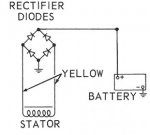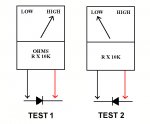I apologize if this is already covered in a past post, but the topics/problems/resolutions I'm seeing surround the rectifier NOT working. Here's what I'm experiencing::
Motor: 1978 Johnson 85ML78C
This past May, my battery was not re-charging while I was running around on the water. After doing some homework, I zero'ed in on the rectifier. Removed it and tested the diodes. 3 of the 4 were dead. Ordered a replacement. Tested the diodes upon arrival - everything looked super. Installed it and tested it with the motor running. The battery was receiving 12.6v to 14v. All good.
Since then, I've been out a dozen times or so. Everything was working & charging fine - except for yesterday. The starter batt voltage dropped all day, winding up to be around 10v at the end of the day. I don't run anything on that battery, other than the depth finder and the radio. The depth finder displays the battery voltage. When the motor ran on previous trips, it would show 13v+ indicating that the starter batt was charging. Yesterday it never perked up as we motored around. I suspected the rectifier had failed - however upon removal and inspection, all 4 diodes test at about 400 (which from what I'm seeing on youtube/internet, indicates a good rectifier).
I also confirmed the battery voltage with an actual volt meter to make sure the depth finder wasn't giving me a false reading.
So.... if the 4 rectifier diodes are testing "good", what else would cause a working charging system to suddenly stop?
Motor: 1978 Johnson 85ML78C
This past May, my battery was not re-charging while I was running around on the water. After doing some homework, I zero'ed in on the rectifier. Removed it and tested the diodes. 3 of the 4 were dead. Ordered a replacement. Tested the diodes upon arrival - everything looked super. Installed it and tested it with the motor running. The battery was receiving 12.6v to 14v. All good.
Since then, I've been out a dozen times or so. Everything was working & charging fine - except for yesterday. The starter batt voltage dropped all day, winding up to be around 10v at the end of the day. I don't run anything on that battery, other than the depth finder and the radio. The depth finder displays the battery voltage. When the motor ran on previous trips, it would show 13v+ indicating that the starter batt was charging. Yesterday it never perked up as we motored around. I suspected the rectifier had failed - however upon removal and inspection, all 4 diodes test at about 400 (which from what I'm seeing on youtube/internet, indicates a good rectifier).
I also confirmed the battery voltage with an actual volt meter to make sure the depth finder wasn't giving me a false reading.
So.... if the 4 rectifier diodes are testing "good", what else would cause a working charging system to suddenly stop?





















